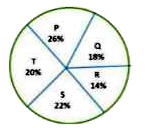PARAGRAPH A There are five students S1, S2, S3, S4 and S5 in a music class and for them there are five seats R1, R2, R3, R4 and R5 arranged in a row, where initially the seat Ri is allotted to the student Si, i=1, 2, 3, 4, 5 . But, on the examination day, the five students are randomly allotted five seats. For i=1, 2, 3, 4, let Ti denote the event that the students Si and Si+1 do NOT sit adjacent to each other on the day of the examination. Then, the probability of the event T1∩T2∩T3∩T4 is 115 (b) 110 (c) 760 (d) 15
115
110
760
15
The correct Answer is:C
Event T1∩T2∩T3∩T4: No two students with consecutive index sit adjacent.
So, we have following possible arrangements:
13524, 14253
24135, 24153, 25314
31425, 31524, 35142, 35241
41352, 42531, 42513
52413, 53142 ltgtbrgt Thus, favorable cases = 14
Hence, required probability = 14120=760
Topper's Solved these Questions
Similar Questions
There are five students S1, S2, S3, S4 and S5 in a music class and for them there are five seats R1, R2, R3, R4 and R5 arranged in a row, where initially the seat Ri is allotted to the student Si, i=1, 2, 3, 4, 5 . But, on the examination day, the five students are randomly allotted five seats. The probability that, on the examination day, the student S1 gets the previously allotted seat R1 , and NONE of the remaining students gets the seat previously allotted to him/her is 340 (b) 18 (c) 740 (d) 15
View SolutionTen students are seated at random in a row. The probability that two particular students are not seated side by side is 4/5.
View Solution
Knowledge Check
There are five students S1,S2,S3,S4 and R5 arranged in a row, where initially the seat R1is allotted to the students are randomly allotted the five seats R1,R2,R3,R4 and R6 arranged in a row, where initially the seat Ri is allotted to the student Sii,=1,2,3,4,5.But,ontheexaminationday,thefivestudentsarerandomlyalloedthefiveseats.<br>(TherearetwoquestionsbasedonParagraph,thequestiongivenbelowiso≠ofthem)<br>Fori=1,2,3,4.≤tT_(i)de¬etheeventtˆthestudentsS_(1)andS_(i+1)doNOTsitadjacent→eachotheronthedayoftheexamination.Then,theprobabilityoftheeventT_(1) cap T_(2) cap T_(3) cap T_(4) is
A115B110C760D16There are five students S1,S2,S3,S4 and R5 arranged in a row, where initially the seat R1is allotted to the students are randomly allotted the five seats R1,R2,R3,R4 and R6 arranged in a row, where initially the seat Ri is allotted to the student Sii,=1,2,3,4,5.But,ontheexaminationday,thefivestudentsarerandomlyalloedthefiveseats.<br>(TherearetwoquestionsbasedonParagraph,thequestiongivenbelowiso≠ofthem)<br>Theprobabilitytˆ,ontheexaminationday,thestudentS_(1)≥tsthepreviouslyalloedseatR_(1), and NONE of the remaining students gets the seat previously allotted to him/her is
A340B18C740D15There are five students - P, Q, R, S and T having different heights in a class. P's height is more than only one student. Q's height is more than S and P but not more than R. S's height is more than P. R is not the smallest. Who is having the maximum height in the class?
AQBRCSDT
The following pie-chart shows the percentage-wise distribution of the number of students in five different schools P, Q, R, S and T. The total number of students in all five schools together is 8400.

Find the average number of students in schools R and S together.
View SolutionFive particles have speeds 1, 2, 3, 4, 5 m/s. The average velocity of the particles is (in m/s)
View SolutionP, Q, R, S, and T are five numbers in ascending order. Their median is M. Find the median of Q/3, R/3, and S/3.
View SolutionThere are five student- P, Q, R,S and T having different heights in a class. P's height is more than only one student. Q's height is more than S and P but not more than R. S's height is more than P. R is not the smallest. Who is having the maximum height in the class?
View Solutionp, q, r, s, t, are five numbers such that the average of p,q and r is 5 and that of s and t is 10. What is the average of all the five numbers ?
View Solution